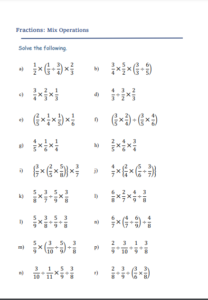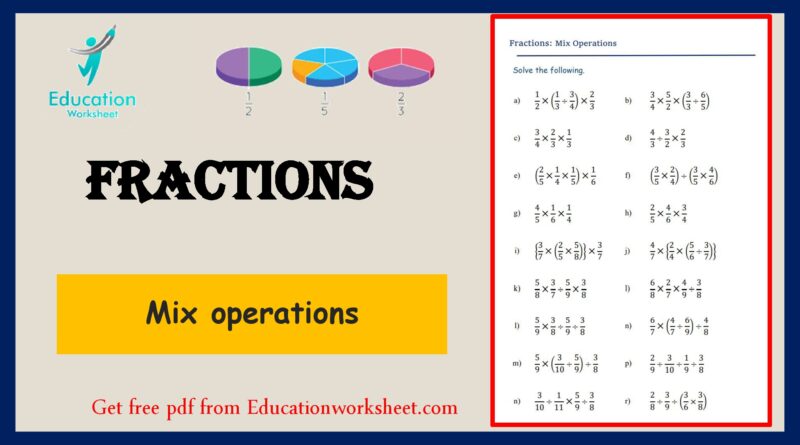Four operations with fractions Worksheets
Four operations with fractions Worksheets
Four operations with fractions Worksheets Fractions are a fundamental concept in mathematics, and understanding how to perform the four basic operations (addition, subtraction, multiplication, and division) with fractions is crucial for success in various mathematical and real-life situations. In this comprehensive guide, we will explore the step-by-step process of creating and solving fractional expressions using each of the four operations. Whether you’re a student looking to improve your math skills or an adult seeking to refresh your knowledge, this guide will provide you with the tools and knowledge needed to confidently work with fractions.
Table of Contents:
I. Addition of Fractions II. Subtraction of Fractions III. Multiplication of Fractions IV. Division of Fractions V. Practical Applications
I.Addition of Fractions :
Adding fractions involves combining two or more fractions to create a single fraction. To add fractions with the same denominator, simply add the numerators while keeping the denominator unchanged. When dealing with fractions of different denominators, you must first find a common denominator before adding. This section will provide detailed instructions and examples to ensure a solid grasp of fractional addition.
II.Subtraction of Fractions :
Subtracting fractions is similar to adding them, but instead of adding the numerators, you subtract them. When subtracting fractions with different denominators, just like in addition, it is crucial to find a common denominator before performing the subtraction. We will explore this process in-depth, including examples that illustrate the steps to take when subtracting fractions.
III. Multiplication of Fractions :
Multiplying fractions involves multiplying the numerators and denominators separately. This section will break down the steps required to multiply fractions, including simplifying the result when possible. You will also learn about multiplying mixed numbers, as well as the significance of reducing fractions to their simplest form.
IV. Division of Fractions :
Dividing fractions can be more complex than the other operations, as it requires you to invert (reciprocal) the divisor and then multiply it with the dividend. We will guide you through the process of dividing fractions step by step, with clear explanations and practical examples. Understanding division is essential, especially when dealing with real-world scenarios where parts of a whole need to be distributed.
V. Practical Applications :
Fractions are not just a theoretical concept; they have numerous practical applications in daily life. This section will briefly highlight some real-world scenarios where knowledge of fraction operations is indispensable. From cooking recipes to carpentry measurements, understanding fractions will help you tackle various tasks with confidence.

Four operations with fractions Worksheets
Conclusion :
Mastering the four operations with fractions is a valuable skill that opens doors to solving a wide range of mathematical problems and applying math in practical situations. By following the guidelines and examples provided in this comprehensive guide, you will develop the proficiency needed to work confidently with fractions, enhancing your mathematical prowess.
perform the four fundamental operations—addition, subtraction, multiplication, and division—using fractions. In this comprehensive guide, we will delve into each operation, providing step-by-step explanations, examples, and practical tips to help you master them.
I. Addition of Fractions
Adding fractions involves combining two or more fractional parts to form a new fraction. To add fractions successfully, follow these steps:
- Find a Common Denominator: To add fractions, they must have a common denominator. If they don’t, you’ll need to find a common denominator by finding the least common multiple (LCM) of the denominators.
- Convert to Common Denominator: Once you have a common denominator, convert each fraction to have that denominator. You do this by multiplying the numerator and denominator by the same value.
- Add the Numerators: After converting to a common denominator, simply add the numerators together while keeping the denominator unchanged.
- Simplify (if necessary): If the fraction can be simplified by finding a common factor between the numerator and denominator, do so to get the simplest form.
- Example: Let’s add 1/4 and 3/8.

